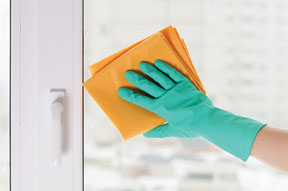Magazines
| << Back |
Going Green: Nature’s Way…A Better Way to Clean
By Hana Haatainen Caye
You’ve put out the recycling, composted your coffee grounds and replaced your old light bulbs with energy efficient ones. You deserve a big ol’ environmental A+! But wait, what is in that spray bottle you’re using? If it’s a cleaning product containing chlorine, phosphates and other chemicals that are harmful to the environment (and your family’s health), your grade just dropped a smidge.
No worries! Bring up your environmental grade curve by cleaning your home nature’s way. Did you know you can eliminate mildew on your walls with undiluted vinegar? Or restore wood by wiping it down with a soft cloth and a mixture of ¼ cup olive oil, ½ cup vinegar and two cups water? You can also make your windows shine with a 50/50 mixture of vinegar and water wiped down with soft microfiber cloths or newspaper. The key ingredients for a naturally spotless home are baking soda, lemons and/or lemon juice, white distilled vinegar, rubbing alcohol and organic dish soap. When used with microfiber or chamois cleaning cloths, a scrubbing sponge, bucket and a cleaned-out recycled spray bottle, you can clean the eco-friendly way, saving a ton of money to boot.
The Heart of the Home
Let’s start in the kitchen, where bacteria love to hide! Keep your dishrags and sponges bacteria-free by soaking them for approximately 8 hours in hot water and ¼ cup vinegar.
Sink – Scour your sink with ¼ cup baking soda, one tablespoon liquid dishwashing detergent, and just enough vinegar to create a thick, creamy texture. Shine up your chrome fixtures by scrubbing them with four parts vinegar to one part salt. Or make your sinks and fixtures sparkle with a halved lemon sprinkled with baking soda on the cut side.
Garbage Disposal – After you’re done scrubbing with the lemon, cut it into smaller pieces and dump it down the disposal. The fresh citrus will have your kitchen smelling clean in no time. You can also make ice cubes out of undiluted vinegar and grind a few cubes in the disposal to kill bacteria; flush with cold running water.
Refrigerator – The walls and shelves of your refrigerator can be safely cleaned with a 50/50 solution of water and vinegar. If the top of your refrigerator has fallen victim to the telltale grime of the kitchen, eliminate it with full strength vinegar.
Microwave – In order to have a sparkling microwave, simply put a glass microwavable bowl inside with a mixture of ½ cup white distilled vinegar and ½ cup water. Heat on high for 90 seconds and wipe clean.
Dishwasher – On a monthly basis, it’s a good idea to run your empty dishwasher through a full cycle with just a cup of vinegar. Skip the rinse agent you usually use; vinegar is a much greener and cheaper solution. Just pour it in the dispenser and let it do its magic.
Homemade dishwashing detergent is another environmentally and economically friendly alternative to commercial brands. Simply add one tablespoon each of 20 Mule Team® Borax and Arm & Hammer® Super Washing Soda to your dishwasher soap dispenser. This averages to about four cents per load.
Countertops – The lemon’s natural antibacterial and antiseptic properties make them perfect for cleaning tile or laminate countertops. Simply spray lemon juice on your counter, let stand for a few minutes, then scrub with a sprinkling of baking soda. Rinse with additional lemon juice.
Granite countertops require a gentler alternative. In a spray bottle, mix one part rubbing alcohol with three parts water and a few drops of dish soap. Apply to granite and polish with a microfiber cloth for ultimate shine. For stubborn stains, mix baking soda with water or rubbing alcohol (for oil based stains) or peroxide (for water based stains) until the consistency of peanut butter. Dampen the stained granite and spread with the soda mixture. Leave until the mixture dries–usually a day or two–and polish with a microfiber towel and rubbing alcohol/water/dish soap solution.
Floor – Grab your spray bottle and add three drops dishwashing soap to 1/3 part rubbing alcohol, 1/3 part water and 1/3 part white distilled vinegar. Spray and mop. If you have tough stains, apply the vinegar full strength, add some baking soda and scrub. Stains can form on travertine flooring if lemon or vinegar is used to clean it, so substitute additional rubbing alcohol and water for the vinegar in the above cleaning solution. Check with the manufacturer’s recommendations for cleaning this and any other type of stone flooring.
The Bathroom
Another germ and bacteria-laden room in your home is the bathroom. Soak your loofah and sponges the same way as your kitchen sponges to keep them fresh.
Bathtub – Stubborn film in the bathtub can be easily eliminated by wiping down your tub with vinegar and then scouring with baking soda. Spray full strength vinegar on shower doors before turning on the shower to avoid hard water deposits.
Showerhead – Fill a plastic bag (an old bread bag works well) with ½ cup baking soda and 1 cup vinegar and fasten it around the showerhead, submerging the head in the solution. Once the bubbling stops (in about an hour) remove the bag and turn on the water. No more scum!
Toilet – Before you head to bed, pour one cup of vinegar into the toilet bowl. Scrub it in the morning and your toilet will be sparkling.
This is just a small sampling of how you can make your home a greener and cleaner environment for your family. Being green never looked and smelled so good!








